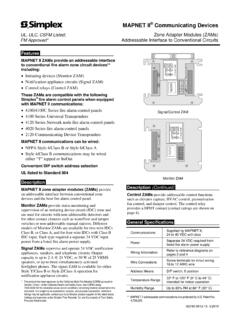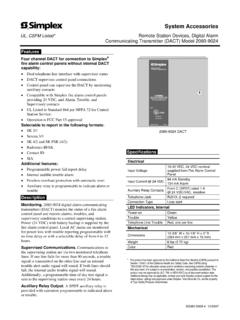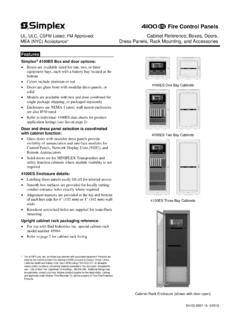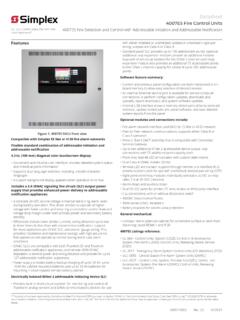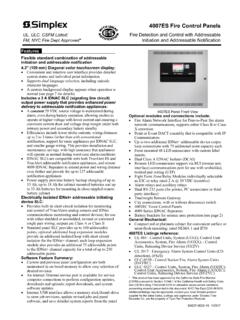Transcription of TrueAlarm Analog Sensing
1 Features Compact air duct sensor housing with clear cover to monitor for the presence of smoke** Includes factory installed TrueAlarm photoelectric smoke sensor and features: Individual sensor information processed by the host control panel to determine sensor status Digital transmission of Analog sensor values via IDNet or MAPNET II, 2-wire communications Programmable sensitivity, consistent accuracy, environmental compensation, status testing, and monitoring of sensor dirt accumulation Model 4098-9755: Basic duct sensor housing (no relay output) powered by IDNet/MAPNET II communications Model 4098-9756: Duct sensor housing with supervised output for multiple remote relays; requires separate 24 VDC; includes one relay Relay output is under panel control At the panel, relay output can be activated manually or in response to a separate alarm or other input General features: UL listed to Standard 268A Clear cover allows visual inspection Test ports provide functional smoke testing access with cover in place Mounts to rectangular ducts or round ducts.
2 Minimum size is 8 (203 mm) square or 18 (457 mm) diameter Magnetic test feature for alarm initiation at housing Optional weatherproof enclosure is available separately (refer to data sheet S4098-0032) Diagnostic LEDs (on interface board): Red Alarm/Trouble LED for sensor status and communications polling display Yellow LED for open or shorted trouble indication of supervised relay control (4098-9756 only) Sampling tubes (ordered separately): Available in multiple lengths to match duct size Installed and serviced with housing in place Remote module options (ordered separately): Remote red status/alarm LED (2098-9808) Remote test station with LED (2098-9806) 4098-9843 remote relays (refer to page 2 for details) * These products have been approved by the California State Fire Marshal (CSFM) pursuant to Section of the California Health and Safety Code.
3 See CSFM Listing for allowable values and/or conditions concerning material presented in this document. Accepted for use City of New York Department of Buildings MEA35-93E. Additional listings may be applicable; contact your local Simplex product supplier for the latest status. Listings and approvals under Simplex Time Recorder Co. are the property of Tyco Fire Protection Products. This device is a duct smoke housing. When provided with detector, it is designed to sample the air flowpassing by it in the air duct to determine whether it contains unacceptable levels of smoke. Theeffectiveness of a duct smoke detector is highly dependent upon: the design and operating conditions of theair handling system in which it is installed, variables such as smoke dilution and stratification over whicheven the best designed systems have no control, and proper placement and positioning of the duct smokedetector, which is often compromised for practical reasons.
4 For the reasons stated above, the effectivenessof this duct smoke detector cannot be warranted or guaranteed. Under no circumstances should this ductsmoke detector be used or regarded to be a substitute for the building's Fire alarm and detection system towhich this device is attached as a secondary detection NOT REMOVE THIS NOTICE! Duct Sensor Housing, Front and Bottom View ALARM TESTNORMALARM 2098-9808 2098-9806 Remote Status/Alarm Indicator and Test Station Introduction Operation. Simplex compact air duct smoke sensor housings provide TrueAlarm operation for the detection of smoke in air conditioning or ventilating ducts. Sampling tubes are installed into the duct allowing air to be directed to the smoke sensor mounted in the housing.
5 TrueAlarm Sensor Operation Digital Communication of Analog Sensing . Analog information from the sensor is digitally communicated to the control panel where it is analyzed. Sensor input is stored and tracked as an average value with an alarm or abnormal condition being determined by comparing the sensor s present value against its average . Intelligent Data Evaluation. Monitoring each photoelectric sensor s average value provides a software filtering process that compensates for environmental factors (dust, dirt, etc.) and component aging, providing an accurate reference for evaluating new activity. The result is a significant reduction in the probability of false or nuisance alarms caused by shifts in sensitivity, either up or down.
6 ** Please note that smoke detection in air ducts is intended to provide notification of the presence of smoke in the duct. It is not intended to, and will not, replace smoke detection requirements for open areas or other non-duct applications. TrueAlarm Analog Sensing UL, ULC, CSFM Listed; FM Approved; Addressable Duct Sensor Housings with TrueAlarm MEA (NYC) Acceptance* Photoelectric Sensor; Available with Multiple Relay Control S4098-0030-10 11/2014 TrueAlarm Sensor Operation (Continued) Control Panel Selection. Peak activity per sensor is stored to assist in evaluating specific locations. The alarm set point for each sensor is determined at the control panel, selectable as the individual application requires.
7 Sensor Status LED. Each sensor housing s red status LED (located on the electrical interface board) pulses to indicate communications with the panel. If the control panel determines that a sensor is in alarm, or that it is dirty or has some other type of trouble, the details are annunciated at the control panel and that sensor housing s status LED will be turned on steadily. During a system alarm, the control panel will control the LEDs such that an LED indicating a trouble will return to pulsing to help identify any alarmed sensors. (Remote Status/Alarm LEDs track the operation of the sensor housing LED.) Photoelectric Sensing TrueAlarm photoelectric sensors use a stable, pulsed infrared LED light source and a silicon photodiode receiver to provide consistent and accurate low power smoke Sensing .
8 Photoelectric Sensing (Continued) Typically duct sensor applications require less sensitive settings (such as per foot obscuration) due to the ducts being a relative dirty environment. However, the standard seven levels of TrueAlarm sensor sensitivity are available for each individual sensor, ranging from to per foot of smoke obscuration. Sensitivity is selected and monitored at the fire alarm control panel. Fire Alarm Control Panel Features Individual smoke sensitivity selection Sensitivity monitoring that satisfies NFPA 72 sensitivity testing requirements Peak value logging allows accurate analysis for sensitivity selection Automatic, once per minute individual sensor calibration check verifies sensor integrity Automatic environmental compensation Smoke sensitivity is displayed in percent per foot Ability to display and print detailed sensor information in plain English language Relays of model 4098-9756 are under panel control for ON, OFF.
9 Or override 2 S4098-0030-10 11/2014 Duct Smoke Sensor Housing with Photoelectric Sensor* Model Description Compatibility 4098-9755 Basic Duct Sensor Housing; operating power is supplied by either IDNet or MAPNET II communications (no relay output) 4007ES, 4008, 4010, 4010ES, 4020, 4100, 4100ES, 4100E, and 4120.
10 Also 2120 CDT if configured for MAPNET II, TrueAlarm operation 4098-9756 Duct Sensor Housing with supervised multiple relay output, requires separate 24 VDC fire alarm power and 4081-9008 end-of-line resistor harness; includes one 4098-9843 relay Same as above except relay operation is not compatible with 2120 CDT; Relay output is for up to 15 total 4098-9843 Relays (additional relays are ordered separately) Remote LED Indicator and Test Station, Select One if Required Model Description Compatibility Mounting 2098-9808 Red LED status indicator on single-gang stainless steel plate 4098-9755 4098-9756 Use single gang box, 3 H x 2 W x 2 D (76 mm x 51 mm x 51 mm) 2098-9806 Test Station with keyswitch and red LED status indicator, on single-gang stainless steel plate; (turning switch to TEST initiates alarm for system testing) Epoxy Encapsulated Remote Relay and End-of-Line Resistor Model Description Compatibility Location 4098-9843 Relay; single Form C (7 A @ 120 VAC).
